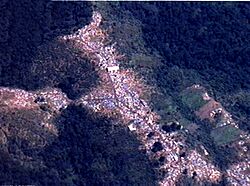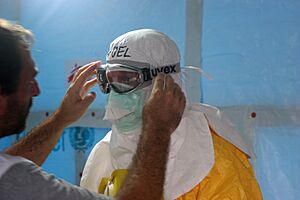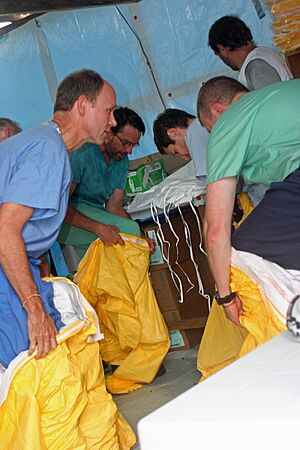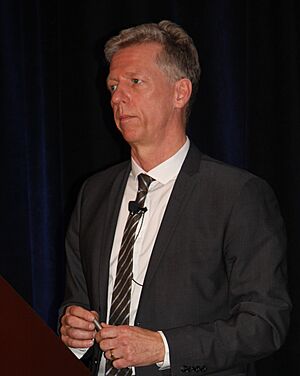Médecins Sans Frontières facts for kids
 |
|
| Founded | 22 December 1971 |
|---|---|
| Founded at | Paris |
| Type | International non-governmental organisation |
| Focus | Humanitarian aid |
| Headquarters |
|
|
Area served
|
Worldwide |
|
International President
|
Christos Christou |
|
Main organ
|
International General Assembly |
|
Revenue (2020)
|
€1.9 billion |
|
Employees
|
45,375 |
Médecins Sans Frontières (MSF), also known as Doctors Without Borders, is a special charity. It gives medical help to people around the world. This group is known for working in places affected by war or serious diseases.
MSF helps people with many health problems. These include diabetes, HIV/AIDS, and tropical diseases. They also help with tuberculosis and provide vaccines. In 2019, MSF worked in 70 countries. More than 35,000 people worked for them. Most were local doctors, nurses, and medical experts. They also had logistics experts and engineers. Most of MSF's money comes from private donors. This helps them stay independent.
MSF started in 1971. A group of French doctors and journalists created it. They wanted to provide medical care to everyone. They believed help should be given no matter a person's background. MSF has offices in different parts of the world. These offices make decisions about their work. The main office is in Geneva, Switzerland.
MSF has a special status with the United Nations. They won the 1999 Nobel Peace Prize. This award recognized their efforts to help people in crises. It also honored their work in raising awareness about humanitarian problems. James Orbinski was the president of MSF when they received the prize.
How Doctors Without Borders Started
Helping People in Biafra (1967-1970)
During the Nigerian Civil War, a region called Biafra was blocked off. Many people there faced starvation and sickness. French doctors volunteered to help. They saw terrible conditions and attacks on civilians. These doctors felt a new aid group was needed. This group would help people no matter what. It would also speak out about the suffering they saw.
MSF's Official Beginning in 1971
Two groups of French medical workers joined together. One group wanted to help in emergencies. The other wanted to help after natural disasters. On December 22, 1971, they formed Médecins Sans Frontières.
MSF's first mission was to Managua, Nicaragua. A big earthquake destroyed the city in 1972. MSF arrived quickly to help. Their first long-term mission was in Honduras in 1974. A hurricane caused huge floods there.
From 1975 to 1979, many Cambodians fled to Thailand. MSF set up its first refugee camp missions there. They also worked in Lebanon during its civil war. MSF helped both sides of the conflict. They treated anyone who needed medical aid. This built their reputation for being neutral.
Who Were the Original Founders?
- Jacques Bérès
- Philippe Bernier
- Raymond Borel
- Jean Cabrol
- Marcel Delcourt
- Xavier Emmanuelli
- Pascal Grellety Bosviel
- Gérard Illiouz
- Bernard Kouchner
- Gérard Pigeon
- Vladan Radoman
- Max Récamier
Important Years for MSF: The 1970s
In the late 1970s, MSF debated how to work. Some believed they should speak out about suffering. This is called témoignage (witnessing). Others thought they should avoid criticizing governments. This discussion was very important for MSF's future.
In 1979, some MSF members helped Vietnamese refugees. They sailed a ship to provide medical aid. This group later formed a separate organization. They believed in the idea of humanitarian intervention. MSF, however, believes in staying neutral. They want to be independent from political powers.
Important Years for MSF: The 1980s
In the 1980s, MSF became more financially independent. They started raising money through mail. More MSF offices opened in different countries. These included Belgium, Switzerland, and the Netherlands.
MSF sent teams to Afghanistan in 1979. They helped people after the Soviet invasion. In 1980, they spoke out against the Khmer Rouge. During a famine in Ethiopia in 1984, MSF set up nutrition programs. But they were forced to leave when they criticized the government. This led to more debates about humanitarian ethics.
Important Years for MSF: The 1990s
The 1990s saw MSF open many new offices. They also worked in very dangerous places.
In 1990, MSF went to Liberia. They helped civilians affected by the civil war. They provided food, basic healthcare, and vaccinations. They also spoke out against attacks on hospitals.
MSF helped Kurdish refugees in 1991. They also started working in Somalia during its civil war. MSF continued their work even when the UN left. They ran clinics and hospitals for civilians.
MSF began working in Srebrenica, Bosnia, in 1993. The city was surrounded by soldiers. MSF was the only group providing medical care. They had to leave in 1995 when the town was captured. Thousands of people were killed.
Rwandan Genocide: A Difficult Time
In April 1994, a genocide began in Rwanda. MSF workers helped keep hospitals running. But the events led to a big debate within MSF. They discussed balancing neutrality with speaking out. MSF-France called for military action to stop the genocide. They said, "One cannot stop a genocide with doctors." This was a very controversial decision.
After the genocide, many Rwandan refugees moved to Zaire. This led to a big crisis with diseases and starvation. MSF-France returned to help these refugees. The events in Rwanda changed how aid groups worked. A "Code of Conduct" was created for humanitarian missions. MSF signed this code. It says aid should be only humanitarian. It should not serve political or religious interests.
Important Years for MSF: The 2020s
MSF played a key role in getting snakebite recognized by the WHO. They helped make it a "Neglected Tropical Disease." This means more focus and funding will go towards treating it. MSF showed that anti-venom was scarce in Africa. They pushed for urgent action.
Where MSF Works Around the World
In 1999, MSF spoke out about the lack of help in Kosovo and Chechnya. They set up missions to help civilians there. MSF provided shelter, water, and healthcare.
MSF has worked in Haiti since 1991. After a major earthquake in 2010, MSF's hospitals were badly damaged. They sent many planes with medical supplies. They also sent a field hospital to treat victims.
MSF has also worked in the Kashmir conflict in India. They help people affected by fighting. They provide psychological support and treat diseases like tuberculosis. Mental health support is very important in many parts of Asia. This is especially true after the 2004 Indian Ocean earthquake.
Helping People in Sub-Saharan Africa

MSF has been active in many African countries for decades. They often provide the only healthcare, food, and water. A major task is treating and educating people about HIV/AIDS. Sub-Saharan Africa has the most cases of this disease. MSF urges governments to increase research for HIV/AIDS treatments. This helps lower costs and increase availability.
Sierra Leone
In the late 1990s, MSF helped people in Sierra Leone. The country was in a civil war. MSF helped with surgeries for people who had lost limbs. They also collected information on attacks against civilians. Long-term projects included psychological support.
Sudan
MSF has provided medical help in Sudan since 1979. The country has faced civil war and starvation. MSF has a large presence there. They provide nutrition support, reproductive healthcare, and surgery. Common diseases include tuberculosis and malaria.
Fighting Kala-Azar in Sudan
Kala-azar is a serious health problem in Sudan. In 2010, MSF opened its first Kala-Azar treatment center. They provide free treatment for this deadly disease. If not treated, almost everyone dies. MSF has cured over 27,000 patients with great success. They also train local health workers.
Improving Healthcare in Sudan
Sudan's civil war ended in 2005. But the healthcare system was very poor. Many people had no access to basic medical care. Malnutrition and disease outbreaks are common. In 2011, an MSF clinic in South Sudan was attacked. Medical equipment was lost. This was serious because MSF was the only healthcare provider there.
Democratic Republic of the Congo
MSF has worked in Congo since 1985. Wars brought more violence and instability. MSF has had to leave some areas due to extreme violence. But they continue to provide food and treat people affected by fighting. They also work to prevent epidemics of diseases like cholera and measles.
Uganda
MSF has been active in Uganda since 1980. They helped civilians during the country's guerrilla war. Later, a group called the Lord's Resistance Army caused much violence. Many people were forced from their homes. MSF set up programs in camps for displaced people. They provided clean water, food, and sanitation. They also give vaccinations and treatment for diseases like Ebola. Mental health support is also important for people who fear attacks.
Ivory Coast
MSF started in Côte d'Ivoire in 1990. Ongoing violence led to massacres. MSF teams even suspected ethnic cleansing. MSF runs mass measles vaccinations and tuberculosis treatment. They also reopen hospitals closed by fighting. MSF is often the only group providing aid in many parts of the country.
West African Ebola Outbreak
During the 2014 Ebola outbreak in West Africa, MSF did much of the medical work alone. Their early warnings were mostly ignored.
Burundi
MSF-Burundi helped people affected by landslides in 2019.
Helping People in Asia
Sri Lanka
MSF works in Sri Lanka. A civil war ended there in 2009. MSF now helps with physical therapy for spinal cord injuries. They also provide counseling. They have set up surgery centers for war-related injuries.
Cambodia
MSF first helped Cambodian refugees in 1979. After many years of war, Cambodia's healthcare system was very weak. MSF moved inland in 1989 to help rebuild basic medical facilities.
In 1999, Cambodia had a malaria epidemic. MSF set up a project to fight malaria. They also introduced new treatments. Cambodia is also heavily affected by HIV/AIDS. In 2001, MSF started giving free treatment to AIDS patients. They also set up clinics to treat HIV/AIDS alongside other chronic diseases. This helps reduce stigma.
MSF also helped after a major flood in 2002. They started a tuberculosis program in villages. They also provide healthcare and counseling in prisons. In 2007, MSF helped with a severe dengue outbreak. They provided medical supplies and staff.
Helping People in the Middle East and North Africa
Libya
The 2011 Libyan civil war led MSF to set up a hospital. They also provided mental health services. The fighting created many patients needing surgery. MSF is working with local health staff. They are the only international aid group with a real presence there.
Search and Rescue in the Mediterranean Sea
MSF helps save migrants' lives in the Mediterranean Sea. These migrants try to cross in unsafe boats. MSF started this mission in 2015. They operate their own rescue ships. They also provide medical teams to other groups. In 2018, MSF had to stop operations of one ship. This was due to attacks and accusations from EU states. Operations resumed in 2019 with a new ship. In 2021, MSF returned to rescue operations with the Geo Barents.
Yemen
MSF helps with the humanitarian crisis in Yemen. This is caused by the civil war. MSF runs hospitals and health centers there. Since 2015, some of their hospitals have been destroyed by airstrikes. In 2016, an airstrike on Abs hospital killed 19 people. MSF had shared the hospital's location with all sides of the conflict.
Helping People in Europe
The Netherlands
In 2022, MSF provided medical care to asylum seekers. These people were staying outside an overcrowded migration center.
Italy
MSF has been active in Italy since 1999. They help migrants, asylum seekers, and refugees. They provide medical, psychological, and social support. They work at arrival points, reception centers, and informal settlements.
As of 2024, MSF works in three main places in Italy. In Calabria, they give medical and psychological aid to arriving migrants. In Ventimiglia, they have a mobile clinic for migrants. In Palermo, they help foreign people who have survived torture. MSF Italy can also give psychological first aid to people who have had traumatic experiences at sea.
How MSF Organizes Its Work
Before MSF starts a mission, a team visits the area. They figure out what kind of emergency it is. They also check how safe the area is. This helps them decide what aid is needed. Medical help is the main goal. But some missions also help with clean water and food.
The Field Mission Team
A field mission team usually has a few leaders. These leaders head different parts of the mission. There is also a "head of mission." This person usually has the most experience. Their job is to talk with the media, governments, and other groups. The head of mission does not always have a medical background.
Medical volunteers include doctors, surgeons, and nurses. They run the medical and nutrition parts of the mission. They also train local medical staff.
Other non-medical volunteers are very important. Logisticians provide everything the mission needs. This includes security, vehicle repair, food, and electricity. They might be engineers. They also help set up treatment centers. Water and sanitation specialists are also on the team. They are engineers who work with water treatment. Financial and human resources experts also help the mission run smoothly.
Medical Care Provided by MSF
Vaccination campaigns are a big part of MSF's medical care. They prevent diseases like diphtheria, measles, and cholera. These diseases are rare in rich countries. But they can spread fast in crowded places like refugee camps. People must be vaccinated quickly. For example, in Mozambique, 50,000 people got a cholera vaccine.
AIDS treatment is also very important. MSF provides drugs and education. They are often the only source of treatment in Africa. They also educate people on how to slow the spread of the disease.
MSF helps local hospitals. They improve cleanliness and provide equipment. They also train local staff. If needed, MSF opens new clinics. These clinics treat specific diseases or help war victims. MSF trains local staff to run these clinics themselves. In some countries, MSF teaches about reproductive health.
People in crisis areas often need psychological support. MSF teams of psychologists help people with depression. They also help survivors of violence. Doctors may train local mental health staff. For example, MSF has a mental health program in a refugee camp in Lebanon.
Nutrition Support
Often, people in MSF mission areas are malnourished. This can be due to war, drought, or bad government. Sometimes, starvation is used as a weapon. MSF provides food and raises awareness. They push for outside help. Infectious diseases and diarrhea can also cause weight loss. These must be treated with medicine and good food.

In emergencies, young children often suffer from malnutrition. MSF sets up "Therapeutic Feeding Centres." These centers treat severe malnutrition. They slowly introduce a special diet. This helps people gain weight after other health problems are treated.
MSF uses special foods for severe malnutrition. One is a therapeutic milk called F-75. It prepares the body for the next stage. Then, F-100 milk is given. A peanut butter mixture called Plumpy'nut is also used. These foods quickly provide many nutrients. Other special foods include enriched flour and a high-protein biscuit called BP5. BP5 is easy to distribute.
Dehydration is also common. MSF sets up rehydration centers. They give a special solution called Oral Rehydration Solution (ORS). This replaces lost fluids. Antibiotics are also given for diseases like cholera.
Clean Water and Sanitation
Clean water is vital for health. It is used for drinking and hygiene. It also helps prevent water-borne diseases. MSF water engineers create sources of clean water. They might dig new wells or treat existing water. Water treatment can involve filtering and chlorination.
Sanitation is a key part of MSF missions. This includes teaching local staff about proper sterilization. It also involves sewage treatment and waste disposal. Educating people about personal hygiene is very important. Proper wastewater treatment prevents serious diseases. MSF can set up simple systems to protect drinking water. They also teach locals so that good waste and water treatment can continue after MSF leaves.
Using Data and Statistics
MSF collects data during each mission. This helps them report conditions to the world. They track malnutrition rates in children. This shows the need for feeding centers. They also track death rates. One way is by watching burials at cemeteries.
By collecting data on diseases, MSF can track epidemics. This helps them prepare with vaccines. For example, they know when meningitis season occurs in Africa.
MSF also surveys violence rates. They estimate the size of massacres. This helps psychosocial programs. It also helps increase safety for people. Surveys can show forced migrations and civilian deaths. MSF uses these results to pressure governments for help. They can even expose genocides. MSF did the first big death survey in Darfur in 2004.
New Ideas and Technology
In 2014, MSF worked with a satellite company called SES. They started a project called SATMED. This project uses satellite internet to bring eHealth to isolated areas. SATMED was first used in Sierra Leone. It helped fight Ebola.
How MSF is Organized
Here are the international presidents of MSF:
- 1991–1992 Rony Brauman
- 1992 Reginald Moreels
- 1992–1994 Rony Brauman
- 1994–1995 Jacques De Milliano
- 1995–1996 Doris Schopper
- 1996–1997 Philippe Biberson
- 1997–1998 Doris Schopper
- 1998–2000 James Orbinski
- 2000–2003 Morten Rostrup
- 2004–2006 Rowan Gillies
- 2006–2010 Christophe Fournier
- 2010–2013 Unni Karunakara
- 2013–2019 Joanne Liu
- 2019–Present Christos Christou
As of 2020, MSF has national offices in many countries:
- MSF Australia
- MSF Austria
- MSF Belgium
- MSF Brazil
- MSF Canada
- MSF Czech Republic
- MSF Denmark
- MSF Eastern Africa
- MSF Finland
- MSF France
- MSF Germany
- MSF Greece
- MSF Hong Kong
- MSF Ireland
- MSF Italy
- MSF Japan
- MSF Republic of Korea
- MSF Lat (Spanish Speaking South America)
- MSF Luxembourg
- MSF Mexico
- MSF Netherlands
- MSF Norway
- MSF South Africa
- MSF SARA (South Asia Regional Association: India, Pakistan, Afghanistan, Sri Lanka, Bangladesh)
- MSF Spain
- MSF Sweden
- MSF Switzerland
- MSF Taiwan
- MSF United Kingdom
- MSF United States
- MSF West and Central Africa
MSF's Own Organizations
Epicentre
In 1986, MSF created Epicentre. This is a research group within MSF. Epicentre trains people and publishes scientific papers. It also develops new techniques for MSF. They do research on diseases and test vaccines.
Campaign for Access to Essential Medicines
This campaign started in 1999. Its goal is to make sure people in developing countries can get important medicines. "Essential medicines" are drugs needed to treat common diseases. But drug companies sometimes stop making these drugs. This is because they are not profitable in rich countries. MSF often lacks effective drugs during missions. So, they started this campaign. They pressure governments and drug companies to fund essential medicines.
In 2006, MSF urged a drug maker to drop a case against India's patent law. This law helps make drugs cheaper. In 2013, an Indian court ruled against the drug maker. This made a cancer drug much cheaper in India.
As of 2022, the campaign focuses on drug resistance and epidemics. Many vaccines and medicines are still not available to people who need them.
Dangers for MSF Staff
MSF staff sometimes face attacks or kidnappings. In some countries, aid groups are seen as helping the enemy. If a mission seems to help only one side, it might be attacked. After the "War on Terrorism," some groups saw MSF as allied with military forces. This made it very dangerous to provide aid. MSF had to leave Afghanistan in 2004. Five staff members were killed in an ambush. In 2007 and 2008, more staff were killed in Africa. This led to projects closing.
Volunteers can also be arrested or kidnapped in unstable regions. Sometimes, MSF missions are forced to leave a country entirely.
Awards Received by MSF
The 1999 Nobel Peace Prize
James Orbinski was the president of MSF when they received the Nobel Peace Prize. In his speech, he talked about the victims of the Rwandan genocide.
Orbinski said that MSF would always speak out. He stated, "Silence has long been confused with neutrality... We are not sure that words can always save lives, but we know that silence can certainly kill."
Other Awards
- 2015 Lasker-Bloomberg Public Service Award
- 2016 Hamdan Award for Volunteers in Humanitarian Medical Services
Other Groups with Similar Names
Many other groups have names ending in "Sans Frontières" or "Without Borders." They were inspired by Médecins Sans Frontières. Examples include:
- Engineers Without Borders
- Avocats Sans Frontières (Lawyers Without Borders)
- Reporters Without Borders
- Payasos Sin Fronteras (Clowns Without Borders)
- Bibliothèques Sans Frontières (Libraries Without Borders)
- Homeopaths Without Borders
The French game show Jeux Sans Frontières (Games Without Borders) is older than MSF. It first aired in 1965.
Books and Films About MSF
- Hope in Hell (2006) by Dan Bortolotti. This book is a doctor's story about his first MSF missions.
- The Photographer: Into War-torn Afghanistan with Doctors Without Borders (2009) by Emmanuel Guibert. This is a graphic novel memoir.
- Living in Emergency: Stories of Doctors Without Borders (2008). This film tells the story of four MSF doctors in Liberia and Congo.
- Six Months in Sudan (2009) by James Maskalyk. This is a doctor's memoir.
- An Imperfect Offering (2008) by James Orbinski. This is a memoir by a former MSF president.
- Triage: Dr. James Orbinski's Humanitarian Dilemma (2007). This is a documentary film.
Images for kids
Contents
- How Doctors Without Borders Started
- Where MSF Works Around the World
- How MSF Organizes Its Work
- How MSF is Organized
- MSF's Own Organizations
- Dangers for MSF Staff
- Awards Received by MSF
- Other Groups with Similar Names
- Books and Films About MSF
- Images for kids
- See also
See also
 In Spanish: Médicos Sin Fronteras para niños
In Spanish: Médicos Sin Fronteras para niños
















